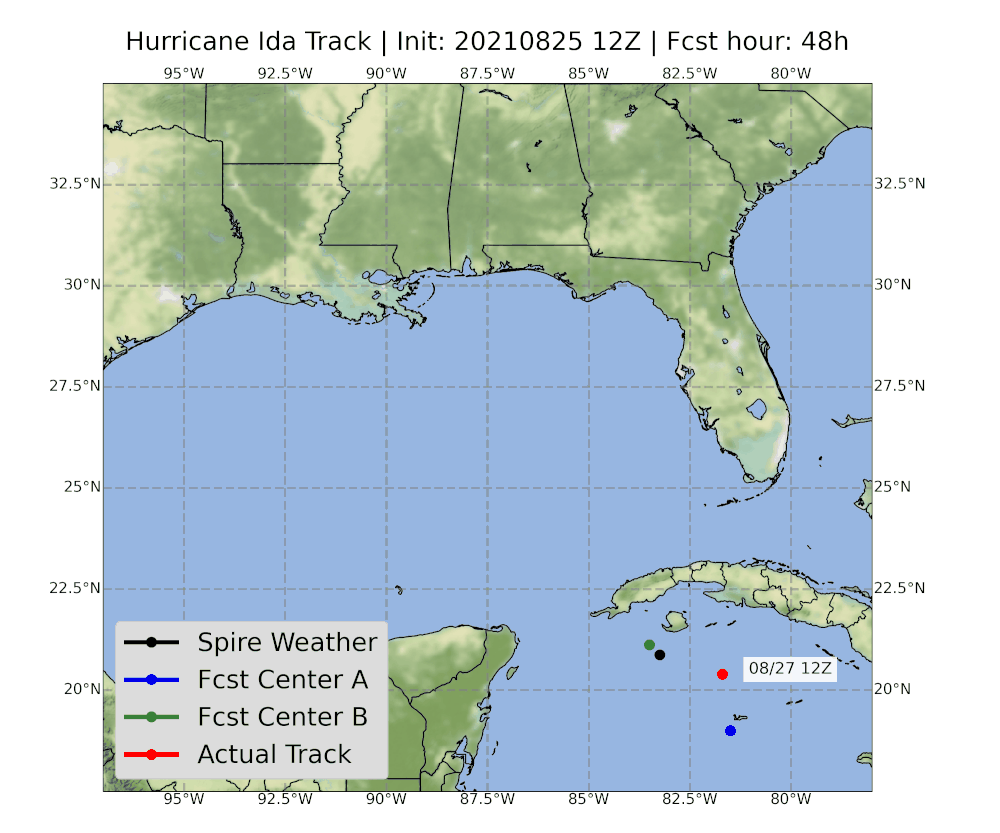Hurricane Ida: how did Oil and Gas platforms stay safe?
Interested in this FREE data set?
How do oil and gas platforms stay safe during these storms and how will this hurricane impact oil and gas markets in the future?
Hurricane Ida ripped through Louisiana last week, devastating the state and leaving many without power for the next 30 days or more. As the gulf states battle their way back from Ida’s destruction, we thought it would be interesting to pull our AIS and Weather data to track activity around offshore supply vessels and see how they prepared and reacted to storm warnings in the region.
Predicting Hurricane Ida

The visualization above compares the tracking of strong low pressure systems in the Spire Weather and two other popular weather forecast models, compared with the actual hurricane track data from the National Hurricane Center (NHC) to show the accuracy of the three models (using 6 day forecasts from all 3 models).
Below is the Spire Weather’s track and model-derived reflectivity of the hurricane.

Offshore Supply Vessels
The Gulf of Mexico is populated with oil and gas structures that are serviced by offshore supply vessels. When a storm is forecasted, it often warrants moving these vessels out of harm’s way. Sheltering in port is possible for only a limited number of vessels and if a storm coming ashore is forecasted as extremely destructive, like Ida, sheltering in port may not be a possibility. Vacating the waterways is the only course of action to save the vessel, the commodity being transported, and protect the safety of the crew.
This video shows an offshore supply vessel traveling to Louisiana on the 27th and leaving on the 28th heading to Houston to avoid Ida:

This graphic depicts offshore supply vessels scattering in the Gulf of Mexico as Hurricane Ida developed. On this map the colored dots are supply vessels for the oil and gas platforms.

This graphic shows the supply vessel activity on September 1, 2021 after Hurricane Ida. The supply vessels returned.
Even more interesting is the significant reduction in traffic seen around New Orleans in particular with a difference of 804 vessels from the first period (2021-08-25 00:00 to 2021-08-29 00:00) compared to the second period (2021-08-25 00:01 to today):

How will this impact gas and oil prices?
Oil and gas prices saw major price cuts due to a lack of demand, surplus supply, and inadequate storage when the COVID-19 pandemic hit in early March 2020. The impact of last year’s Hurricane Laura and Hurricane Marco combined with pandemic fueled low costs, gas prices jumped only a few cents per gallon on average and oil moved only a few percentage points.
Texas, Louisiana, and California are the three main refinery states in the United States. A refinery based-state and it’s ports are congested and bustling with oil and gas tankers on a regular basis. Storms impact maritime businesses in the worst ways, including unplanned fuel costs when vessels need to veer off course to avoid dangerous storm waters and high winds and insurance claims as the result of business outages and damage.
Oil markets dropped last August from a six-month high as Hurricane Laura swept through key refining facilities on the U.S. Gulf Coast. More than 84% of oil output in the Gulf of Mexico was shut down due to Laura, and nearly 3 million barrels a day of refining capacity was lost.
The impact of Ida on gas and oil prices and production remains to be seen.